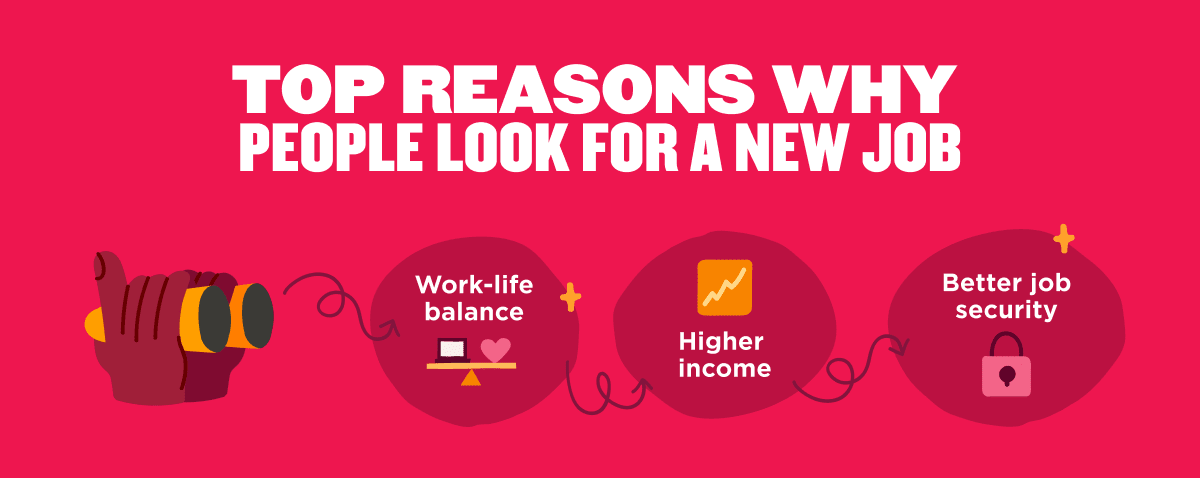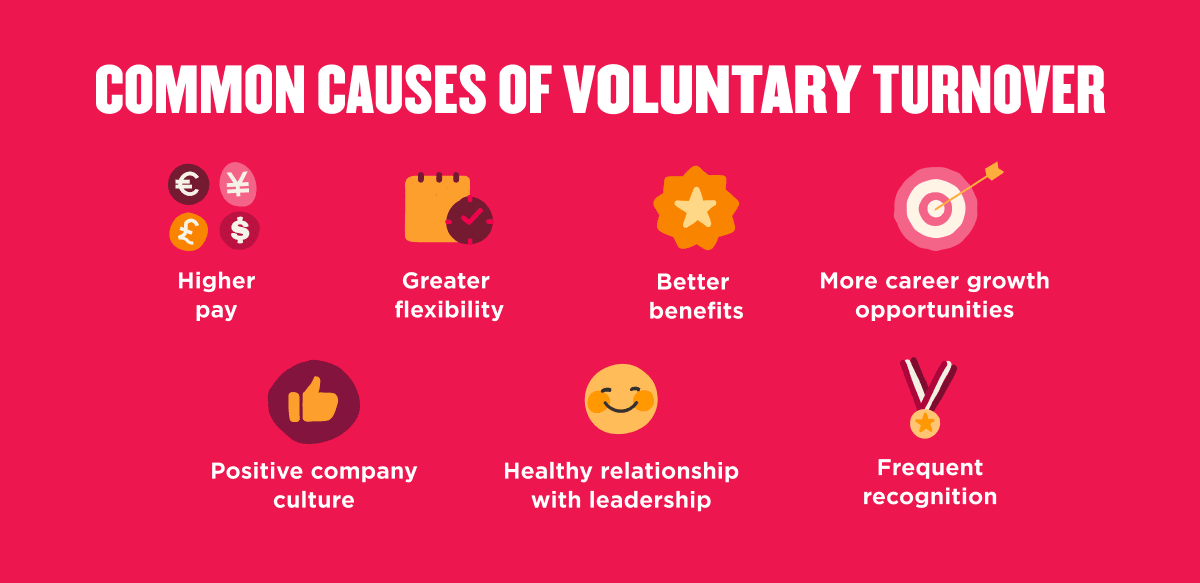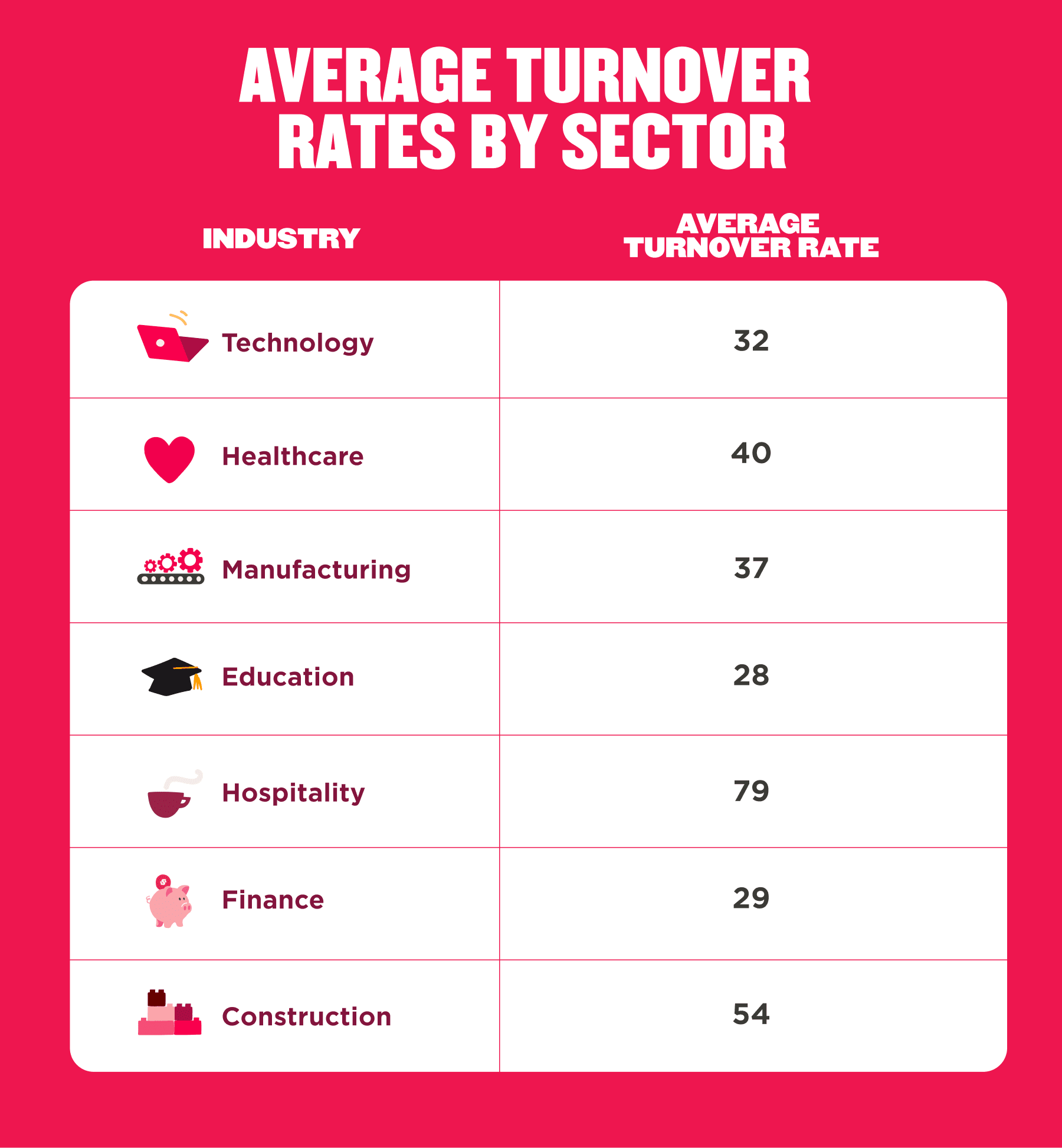Employee turnover is an HR metric that measures the rate at which people leave their jobs, voluntarily or involuntarily, during a specific period of time.
Employee turnover is one of the clearest indicators of a company’s workplace dynamics. It measures how often people are offboarded—whether voluntarily or involuntarily—and highlights trends that can reveal deeper cultural, managerial, or structural challenges.
High turnover often signals underlying issues that go beyond compensation or job titles. According to a recent Gallup report, over 50 percent of U.S. workers are looking for a new job. The most cited reasons include looking for a better work-life balance, higher salaries, and improved job security. That’s why understanding your turnover rate is essential to building a workplace where people want to stay.
We’ll review the costs of turnover, how to calculate your turnover rate, and how to reduce turnover in your organization

What is employee turnover?
Employee turnover is an HR metric that measures the rate at which people leave their jobs, voluntarily or involuntarily, during a specific period of time.
Turnover reflects the quality of the employee experience. A healthy turnover rate can reflect an engaged, well-supported workforce, while consistently high turnover may signal opportunities to improve people’s experience and strengthen workplace culture.
<< Increase retention by offering flexibility and professional development. >>
What is the cost of turnover?
The cost of turnover goes beyond hiring ads and onboarding checklists. Every departure represents a loss of time, knowledge, and momentum. Companies invest significant resources into bringing someone new on board, and those costs can add up.
Replacing a leader can cost up to 200 percent of their annual salary, while filling technical roles is estimated to cost around 80 percent of the position’s salary. These are more than just numbers. For companies like ANYMOVE, turnover data helped demonstrate a clear business case. Pascal Frühling, the company’s senior people and culture business partner, noted: “By lowering turnover by a certain percentage, you’re actually net positive on the impact of your company.” It’s a compelling reminder of why investing in retention strategies early pays off.
The impact of having a high turnover rate can extend beyond a company’s budget. High turnover can disrupt team dynamics, lower morale, and decrease engagement. This can weaken company culture if left unaddressed. Reducing turnover can help preserve institutional knowledge, strengthen relationships, and reinforce the kind of workplace people want to grow with.
How to calculate employee turnover rate
Employee turnover is an easy HR metric to calculate. Divide the number of departures at your organization during the period by the total number of people and multiply by 100 to get the percentage. The formula looks like this:

To understand how this formula works, consider the following:
- Total number of team members: This is the count of all people at the start of the period
- Average number of team members: Calculate this by adding the total number of team members at the beginning and end of the period and dividing by two
- Total number of leavers: This includes all voluntary and involuntary departures during the period
For a year-to-date (YTD) calculation, simply track the total number of leavers and the average number of team members throughout the year. Apply the same formula to gain insights into your annual turnover trends.
Causes of employee turnover
Turnover happens either because people leave voluntarily or because the employer dismisses them (i.e., an involuntary departure).
<< Download the free guide to being a great HR leader. >>
Voluntary turnover
Voluntary turnover doesn’t happen in a vacuum. Team members often leave because they find better alignment with their values, goals, and lifestyle elsewhere. Understanding why people choose to move on is key to building the kind of workplace they want to stay in. Here are some of the most common reasons:
- Higher pay: People often seek roles that better reflect their contributions, both in compensation and overall value. Benchmarking salaries and offering fair, transparent pay can help close the gap before someone starts looking.
- More flexibility: Flexible hours or remote options are no longer just perks; they’re expected. Companies that offer autonomy around when and where work happens provide a better work-life balance, making it more likely to retain top talent.
- More time off: Generous vacation or paid time off (PTO) policies show trust and support for work-life balance. When companies encourage time to recharge, they attract professionals who value wellbeing and a people-first culture.
- Better benefits: Comprehensive benefits packages, including health insurance and wellness programs, play a big role in retention. People want to feel cared for beyond the paycheck.
- Career growth: Growth opportunities are essential in keeping people engaged. Providing regular development plans and internal career pathways shows your investment in their future.
- A positive company culture: Team members stay where they feel like they belong and where they feel aligned with company values. Building an inclusive, supportive culture builds loyalty from day one.
- A healthy relationship with leadership: People don’t just leave jobs, they leave managers. Transparent communication, consistent feedback, and mutual respect can make all the difference.
- Recognition: Employee recognition also plays a major role—71 percent of team members say they’re less likely to leave their workplace when they feel recognized. A simple ‘thank you’ can go a long way. When people feel seen and valued, they’re more likely to stay committed.
Pro Tip: Regularly check in with your team through stay interviews and team member engagement surveys to uncover what motivates your team. Companies like Amdaris use this approach to stay closely connected to their people and create a culture where feedback drives continuous improvement. Understanding what keeps people engaged can help you address concerns before they start looking elsewhere.

Involuntary turnover
Involuntary turnover occurs when an organization decides it’s time for a separation. These decisions are never easy, but they’re sometimes necessary to protect team health, uphold company values, or meet changing business demands. Understanding the common causes of involuntary turnover can help HR leaders approach these situations with transparency, empathy, and fairness.
- Ongoing performance issues: When someone consistently underperforms, even after coaching, feedback, and development opportunities, separation may be the next step. Clear documentation and a fair, supportive performance improvement plan (PIP) are essential to ensure objectivity.
- Organization-wide layoffs: Economic shifts, mergers, or operational restructures can lead to difficult but necessary reductions. While the decision is organizational, how it’s handled, through transparent communication, transition support, and empathy, matters deeply to both departing and remaining team members.
- Business or behavioral misconduct: Misconduct, whether ethical breaches, harassment, or repeated policy violations, can damage team trust and culture. A consistent and values-based approach to accountability helps protect the safety and integrity of the workplace.
Pro Tip: Handle exits with empathy and transparency. A respectful offboarding process protects your culture, supports team morale, and leaves the door open for future collaboration.

What is a healthy employee turnover rate?
An organization can’t—and shouldn’t—keep everyone. While an overly high turnover rate can reflect poorly on a company, some level of turnover is normal. Letting go of team members who aren’t thriving in their roles helps maintain team balance and opens the door for new hires who are better equipped to grow, contribute, and support the business’s long-term goals.
Overall, U.S. turnover trends are heading in a positive direction. Voluntary turnover dropped to 13.5 percent in 2024, down from 17.3 percent in 2023, indicating that retention efforts may be paying off.
However, there isn’t a one-size-fits-all healthy turnover rate. It depends on the industry, the size of the company, and economic and social factors.
Turnover rates by industry
Some industries find it especially challenging to fill positions. According to Mercer, sectors like healthcare, technology, and hospitality often face the toughest hiring landscapes. Here are some turnover rates by sector:

Sources: https://www.awardco.com/blog/employee-turnover-rates, https://www.bls.gov/news.release/jolts.t20.htm
Focusing on the unique challenges of each industry helps companies build stronger teams, improve employee satisfaction, and create a more stable, engaged workforce.
Recommended For Further Reading
Who is responsible for employee turnover?
Building a healthy work environment is a team effort and requires everyone, from C-level decision-makers to managers and HR, to work together. A recent study shows that 42 percent of team members who voluntarily left a company said their manager or organization could have done something to prevent them from leaving, highlighting the critical role leadership plays in retention.
HR is responsible for helping leadership better understand what their people want and how to deliver it. It’s also important to provide managers with training so they can become more effective leaders who spark higher levels of engagement and cultivate enthusiasm among their teams about working for the company. That kind of culture-building is something companies like Novatti have prioritized, creating stronger team connections across their global workforce.
How HR can help reduce turnover
While decreasing turnover in the US is a good sign, it’s important for HR leaders to stay proactive to keep that momentum going. Here are five practices to implement for lower turnover rates:
- Gather feedback from people on their way out. Departing staff can offer a wellspring of valuable information. HR can learn what factors fueled the decision to leave by conducting an exit interview— whether it was a poor onboarding experience, burnout from heavy workloads, limited growth opportunities or challenges with culture and leadership. Discovering what factors catalyzed the departure can provide clues on how to improve the team member experience for everyone else.
- Educate managers to engage. Managers play a crucial role in turnover. According to the Gallup Business Journal, poor management can be the root cause of 33 percent of voluntary turnover. Equipping managers with the skills to build positive relationships, communicate expectations, and inspire motivation can help you significantly reduce turnover.
- Leverage turnover to elevate your workforce. Turnover can transform a company for the better by creating opportunities to hire high-performing, motivated people to fill open positions.
- Engage top talent. Sometimes the loss of skilled co-workers can negatively impact morale, and replacing these professionals is costly. Offering career development options, competitive compensation plans, or better benefits can promote engagement and lower turnover among in-demand professionals.
- Build a work community. Forging connections with co-workers, through virtual platforms or in-person team-building activities, strengthens the work community. Companies can further emphasize inclusivity by welcoming and celebrating peoples’ accomplishments through recognition programs. Creating a positive, vibrant culture nurtures camaraderie, fuels motivation, and wards off voluntary turnover.
- Improve tracking and employee turnover reduction with an HRIS. Using a human resource information system (HRIS), you can keep records of who’s leaving and analyze the data to determine why. The best HRIS platforms centralize team members’ relevant personal information, their length of employment, performance reviews, and survey responses. With access to this data, companies like LeoVegas are able to evaluate whether their turnover rate is voluntary or involuntary and gain insights into how to reduce it within specific departments or positions.
Key takeaways
- Employee turnover measures how frequently people leave an organization within a specific timeframe, reflecting the overall team member experience
- High turnover often signals unfavorable work conditions, while low turnover typically suggests a healthy workplace
- HR professionals can calculate turnover by dividing the total number of people by the number of departures during the period
- Voluntary turnover is driven by factors like career growth and work-life balance, whereas involuntary turnover is due to performance or organizational changes
- Reducing turnover requires HR to focus on feedback, training managers, and enhancing engagement through competitive benefits and a positive work culture
Why HR leaders care about turnover
While a high turnover rate can signal challenges within the workplace, it also presents an opportunity for reflection and growth. Elevated turnover may point to gaps in engagement, development, or leadership—but identifying those areas allows organizations to make meaningful changes that benefit the entire team. When people leave, it can impact morale and create added costs, but it also opens the door to fresh perspectives and smarter workforce strategies.
Alternatively, by keeping turnover at a reasonable rate, companies can spend less money on sourcing, hiring, and training people and instead focus their resources on investing in their current workforce, preserving productivity, and accomplishing business goals.
Turnover rates indicate a company’s internal state of health and its ability to retain talent. Approaching turnover with intentional, strategic planning, HR professionals can build an engaged workforce, improve the bottom line, and boost the company brand.
Employee turnover FAQs
What do turnover rates say about a business?
Turnover rates give leaders a snapshot of a company’s internal environment. High turnover can suggest there’s challenges like ineffective management or outdated policies. Low turnover often highlights a company’s strength in promoting a positive and engaging work culture where people feel appreciated and motivated.
Why is employee turnover important?
Employee turnover affects more than just budgets—it influences team morale, productivity, and long-term success. When companies take the time to understand why people leave, they gain the insight needed to build stronger retention strategies, strengthen team dynamics, and create a workplace where people feel motivated to stay and grow.
